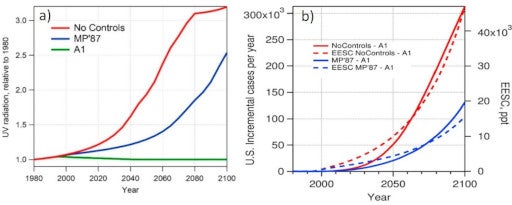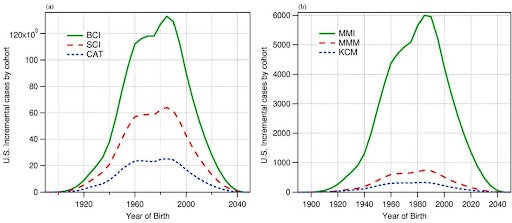The Benefits of the Montreal Protocol for Skin Cancer Rates
Overexposure to ultraviolet (UV) radiation can cause skin cancer and cataracts, and is a threat to human health. As early as 1974, it was recognized that human-made chlorofluoromethanes, although inert in the troposphere, release chlorine (Cl) atoms upon reaching the stratosphere and cause efficient catalytic destruction of ozone. This increases the amount of UV radiation reaching Earth’s surface, potentially causing more disease. The levels of concern rose significantly in 1985 with the unexpected discovery of the Antarctic ozone hole and over the next decade with the realization that heterogeneous Cl chemistry can deplete substantially more ozone than gas phase processes alone. To protect and restore the ozone layer, the Montreal Protocol on Substances that Deplete the Ozone Layer was enacted in 1987 to phase out the production and consumption of certain ODSs (Ozone-Depleting Substances) and was later amended and adjusted to significantly strengthen its requirements.
ACOM scientists have been instrumental in the development and implementation of the United States Environmental Protection Agency (EPA) Atmospheric and Health Effects Framework (AHEF) model, which helps EPA to fulfill its regulatory obligations by assessing the ground-level UV radiation (Figure 1a) and consequent adverse human health effects (Figure 1b) associated with stratospheric ozone depletion. In a recent publication, the team demonstrated that the global implementation of the Montreal Protocol and its amendments and adjustments gave specific U.S. health benefits. Compared to a scenario of no controls on ODSs, we estimated that the original Montreal Protocol resulted in the prevention of 223 million skin cancer cases, 30 million cataract cases, and 1.0 million fewer skin cancer deaths for people born in the United States between 1890 and 2100. However, the original Montreal Protocol still allowed for runaway ozone depletion. It was subsequently strengthened with amendments and adjustments to allow stratospheric ozone to return to pre-1980 levels. This current set of ODS regulations roughly doubles the estimated total health benefits. We estimate that, again for people born in the United States between 1890 and 2100, 443 million skin cancer cases, 63 million cataract cases, and 2.3 million skin cancer deaths are prevented. People born after 2040 are predicted to have no UV-related health impacts resulting from ODS-induced ozone depletion (Figure 2).
This work was of significant public interest and was featured by numerous press outlets including Scientific American and Mashable.


Reference:
Madronich, S.; Lee-Taylor, J.; Wagner, M.; Kyle, J.; Hu, Z.; Landolfi, R. (2021), Estimation of Skin and Ocular Damage Avoided in the United States through Implementation of the Montreal Protocol on Substances that Deplete the Ozone Layer, ACS Earth and Space Chemistry, doi: 10.1021/acsearthspacechem.1c00183.
UCAR press release:
Protecting the ozone layer is delivering vast health benefits at UCAR News; October 6, 2021.